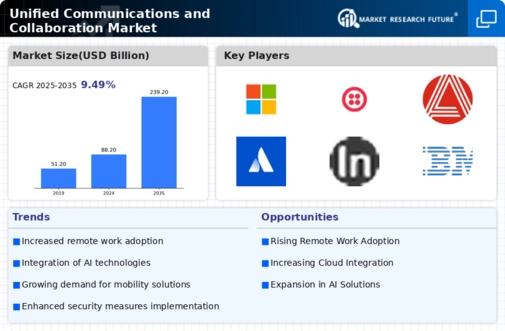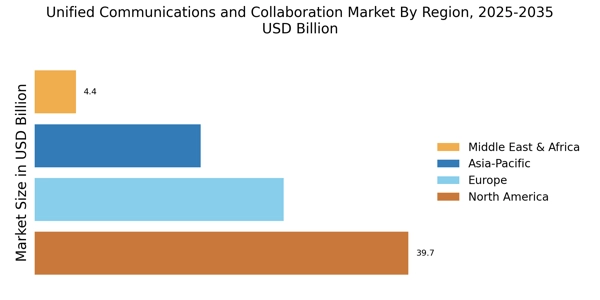The Unified Communications and Collaboration Market is currently characterized by a dynamic competitive landscape, driven by rapid technological advancements and an increasing demand for integrated communication solutions. Major players such as Microsoft (US), Cisco (US), and Zoom (US) are at the forefront, each adopting distinct strategies to enhance their market positioning. Microsoft (US) emphasizes innovation through its continuous development of Microsoft Teams, integrating AI capabilities to streamline workflows and improve user experience. Cisco (US), on the other hand, focuses on strategic partnerships and acquisitions to bolster its portfolio, particularly in security and cloud services, thereby enhancing its competitive edge. Zoom (US) has pivoted towards expanding its offerings beyond video conferencing, venturing into areas like event management and customer engagement solutions, which collectively shape a competitive environment that is increasingly collaborative and technology-driven.
In terms of business tactics, companies are increasingly localizing their operations and optimizing supply chains to respond to regional demands effectively. The market structure appears moderately fragmented, with a blend of established players and emerging startups vying for market share. This fragmentation allows for diverse offerings, yet the collective influence of key players like Microsoft (US) and Cisco (US) tends to dominate market trends and consumer preferences.
In August 2025, Microsoft (US) announced a significant upgrade to its Teams platform, incorporating advanced AI features aimed at enhancing productivity and collaboration. This strategic move not only reinforces Microsoft’s commitment to innovation but also positions Teams as a central hub for workplace collaboration, potentially increasing its user base and engagement levels. The integration of AI is likely to set a new standard in the market, compelling competitors to enhance their offerings.
In September 2025, Cisco (US) unveiled a new suite of security features for its Webex platform, aimed at addressing growing concerns over data privacy and security in remote communications. This initiative underscores Cisco's strategic focus on security as a differentiator in the crowded UCaaS market. By prioritizing security, Cisco not only enhances its value proposition but also aligns with increasing regulatory demands, thereby solidifying its market position.
In October 2025, Zoom (US) launched a new customer engagement tool designed to facilitate seamless interactions between businesses and their clients. This move reflects Zoom's strategy to diversify its product offerings and cater to a broader audience beyond traditional video conferencing. By enhancing customer engagement capabilities, Zoom aims to capture a larger share of the market, indicating a shift towards more integrated communication solutions.
As of October 2025, the competitive trends in the Unified Communications and Collaboration Market are increasingly defined by digitalization, sustainability, and the integration of AI technologies. Strategic alliances are becoming pivotal, as companies seek to leverage complementary strengths to enhance their offerings. The competitive differentiation is likely to evolve from traditional price-based competition towards a focus on innovation, technological advancements, and supply chain reliability, suggesting a future where adaptability and responsiveness to market needs will be crucial for success.


















Leave a Comment